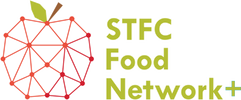|
Dr Jens Jensen describes himself as ‘a mathematician, scientist, research software engineer, IT project manager and people manager’ at the STFC’s Scientific Computing Department, based at the Rutherford Appleton Laboratory in Harwell. Through his involvement in the STFC Food Network+ (SFN+) he has added to these roles that of being a Champion for Data Science. Having worked on a phenomenal range of data-based projects over his career– from Internet of Things technologies to the Large Hadron Collider – he provides invaluable expertise to scoping and proof-of-concept projects funded by the SFN+.
He talks about why he became an SFN+ Champion for Data Science; what makes the SFN+ special to him; and the common challenges of data-based projects. How would you describe your role as an SFN+ Champion for Data Science? Basically, I seem to have got myself a reputation as the ‘go-to’ data science guy within the SFN+. Through my career, I have developed extensive experience in data science, data security, and data infrastructure. So, I am well used to dealing with the common challenges that any project with a data-based component will encounter. Almost every SFN+ project has a data-based component, whether this is gathering data to better understand the issues underlying a problem, or applying datasets in new ways – for instance, to develop an overall sustainability metric for different food products. I work with the project teams to develop a secure and user-friendly data architecture. How many SFN+ projects have you supported so far? I have honestly lost count! The level of support varies from a very active involvement, such as writing software or data analysis, to offering guidance or supervising a student. But there are common themes across different data-based projects, so after I have developed a solution once it can often be repurposed, for instance, a supply chain management tool that can be adapted for different food products How did you first become involved with the SFN+? I originally got involved through a colleague, who wasn’t able to attend the second SFN+ sandpit in March 2019 and suggested I went in his place. I came back having agreed to support five different projects! I hadn’t intended to get so involved all at once. But when people were sitting down in groups to discuss their ideas, I found myself walking around and suggesting things for them to consider, particularly for data analysis. So, one thing led to another… and at the next year’s sandpit, the same thing happened. What sort of skills do you provide? My core skills are computing, mathematics, and Big Data analysis. I am used to working with data from huge instruments, including the Large Hadron Collider and Square Kilometre Array. A common issue with SFN+ projects is data not being in a standardised form. For example, one project was looking at issues with prawn production overseas (particularly important for the UK since we import nearly all of the prawns we consume) and we were working with various spreadsheets on prawn production. But each one was slightly different from the others, measuring things in slightly different ways. In these situations, you can’t just put everything you have into an analysis tool and process it. Tidying up data can be very time-consuming! Another way I can support projects is to connect them with other experts, if I am not the right person to help them. Having worked at STFC RAL for over 20 years, I usually know who to ask, whether this is to access a facility, or to advise on a particular type of dataset. What do you enjoy about supporting SFN+ projects? Two things stand out in particular. First, the diversity of the community that the SFN+ has brought together – people from different backgrounds, with different skills and abilities. At the sandpit events, for instance, you will typically have chemists, biologists, food scientists, technicians, and data scientists like me, but it just works. I feel there is a very special culture when diverse groups of people physically get together to come up with ideas. I have a lot of happy memories from SFN+ workshops that have involved sketching out ideas on whiteboards and building things with our hands. It is very refreshing in this age when our days are dominated by online meetings. Another key factor is the network’s global outreach, particularly in Asia and Africa, and the focus on involving local stakeholders. Often, SFN+ projects investigate a highly specific issue with a particular supply chain, so involving local partners enables them to generate tailored evidence. For example, a project could fund a local research assistant to survey farmers in Africa to understand the issues preventing them from selling their produce more effectively on the market. We can then discuss ideas on how to better facilitate the link between suppliers and consumers. Why is the SFN+ important? I think where the SFN+ really succeeds is by addressing the gap in funding between an idea in someone’s head that may work, and having the proof-of-concept needed to attract lots of investment. Many of the projects I have supported have been able to develop a cheap and cheerful prototype that then acts as a catalyst for further funding. Or they have been able to publish datasets in the public domain that others can then build on. In this respect, the SFN+ really complements the other parts of UKRI. It also enables small-scale and early-stage projects to access STFC’s world class facilities, such as the Diamond light source and the ISIS neutron and muon source. Finding the right person to talk to and gain access would be much harder without the inside channels that the SFN+ provides. How successful do you think the SFN+ has been? I would say that it is an exemplary model for a research network, particularly in terms of productivity. This goes far beyond making physical things: ‘productivity’ can include publications – of papers, code, datasets, etc – presentations at conferences, engaging with food industry companies, growing networks, and making new contacts. Above all, the SFN+ has enabled many proof-of-concept projects to build a persuasive enough case to apply for follow-on funding elsewhere. Involving PhD students is also an important activity. We make sure that they have a well-defined contribution to the project that they can finish within the timescale of their PhD. This can give them experience of on-the-ground data collection, for instance surveying farmers or other stakeholders in a food supply chain, which is a valuable asset for their CV.
0 Comments
 Selvarani Elahi, the UK Deputy Government Chemist Selvarani Elahi, the UK Deputy Government Chemist The STFC Food Network+ (SFN)’s impacts go beyond the researchers directly involved in funded projects. For instance, Selvarani Elahi MBE, the UK Deputy Government Chemist since 2011, became involved with the SFN after giving the keynote talk at the SFN+ Fifth Annual Conference (03-04 July 2023). She describes the benefits this has led to, and how the SFN’s global reach inspires her. Safety is a critical issue for food systems, both to safeguard public health and to give consumers confidence in healthy, sustainable food products. As the food landscape evolves, introducing novel ways to produce, process, and retail foods, this presents a constant stream of new food safety challenges. At the SFN+ fifth Annual Conference, a range of projects supported by the network demonstrated how they are applying cutting-edge techniques to achieve impact in this area.
Scaling up food production to feed the growing population would be a daunting challenge by itself, but somehow this must be achieved in the face of climate change, degraded natural resources, and increasing pressures on land, water and energy use. However, as the SFN’s 2023 Annual Conference demonstrated, projects supported by the network are redefining how we grow and produce our food – offering hope for a future of ‘Smart and Sustainable Agriculture.’
Efforts to increase food security often focus either on the production side or consumer behaviour. But the supply chains linking the two can have an enormous impact on how resilient food systems are – as demonstrated all too well during the disruption of the COVID-19 pandemic. Besides this, the global and often highly distributed nature of food supply chains means these offer countless intervention points to improve the sustainability and social benefits of food products.
Fish for all - How digital marketplaces could radically improve Farmed fish distribution in Kenya12/7/2023 A project supported by a STFC Food Network (SFN) Scoping Project Grant has demonstrated how digital technologies could help create a thriving farmed fish economy in Kenya – supporting livelihoods and increasing access to healthy protein.
With support from the STFC Food Network+ (SFN+), this project is modelling a future of local, ‘closed-loop’ urban food production systems where nothing goes to waste.
With funding from an STFC Food Network+ (SFN+) Scoping Grant, an exciting project has shown the potential for computational genetics to detect the most dangerous strains of a notorious food-borne bacteria, Shigatoxigenic E. coli
With support from the STFC Food Network+ (SFN), an interdisciplinary collaboration is breaking new ground in developing low-cost, accurate and autonomous technologies to measure soil properties.
A project supported by a STFC Food Network+ (SFN) Scoping Grant has found that borrowing solutions from space technologies could make a dramatic difference in reducing food loss in developing countries.
|
AuthorJune 2024 - Archives
June 2024
Categories |
- Home
- Webinars and Events
- About the SFN+
- News
- Blog
- Expert Working Groups
- Funding
-
Publications
- Bioeconomy positioning paper
- SFN+ 5th Annual Conference
- OMM Policy Report
- ‘Multi-Stakeholder International One Day Workshop on Organic Agri-Food Value Chains for Net Zero’ Report
- SFN 2050 UK Net Zero Food report
- Sustainable Cold Food Chain Booklet
- Food Sensing Technologies for Safe and Nutritious Food
- Sustainable urban and vertical farming
- Projects
- Join/Contact Us

 RSS Feed
RSS Feed


